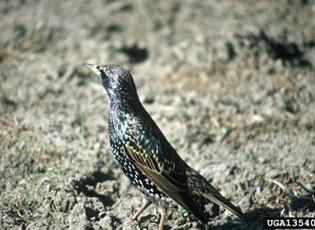Sturnus vulgaris Linnaeus, 1758 (ITIS)
European starling, common starling, English starling
Eurasia and northern Africa (Linz et al. 2007)
1890-91 (Cabe 1998)
Introduced by Eugene Schiefflin as part of a plan to introduce to the U.S. all birds mentioned in the works of Shakespeare (Cabe 1998)
Causes $800 million in agricultural damage annually (Linz et al. 2007)
European starling populations have spread across North America making them common and widespread.

European Starling, Adult
Lee Karney USDA, Agricultural Research Service.
Find more images
Spotlights
Distribution / Maps / Survey Status
All Resources
Selected Resources
The section below contains highly relevant resources for this species, organized by source.
Partnership
Federal Government
International Government
State and Local Government
Cabe, P.R. 1998. The effects of founding bottlenecks on genetic variation in the European starling (Sturnus vulgaris) in North America. Heredity 80:519-525.
Integrated Taxonomic Information System. Sturnus vulgaris. [Accessed Aug 31, 2023].
Linz, G.M., H.J. Homan, S.M. Gaulker, L.B. Penry, and W.J. Bleier. 2007. European starlings: a review of an invasive species with far-reaching impacts with far-reaching impacts [PDF, 106 KB]. In: Managing Vertebrate Invasive Species: Proceedings of an International Symposium, pp. 378-386.
